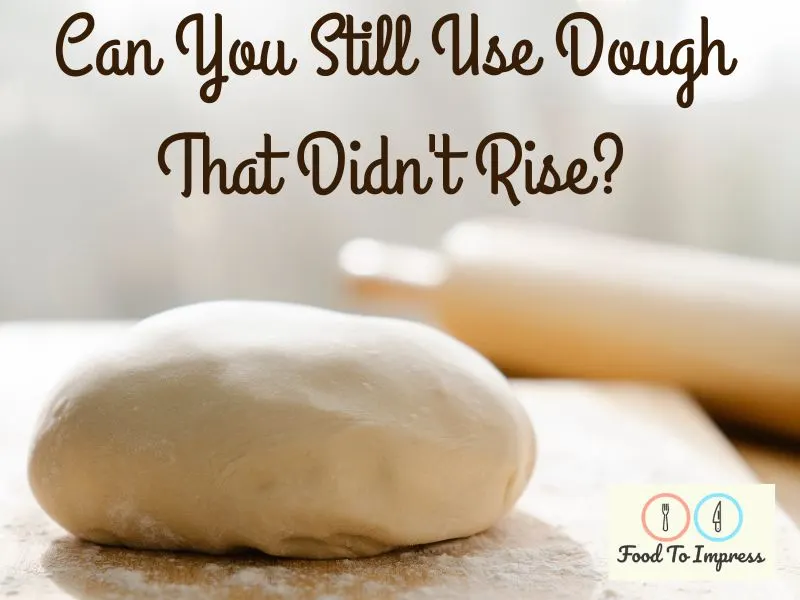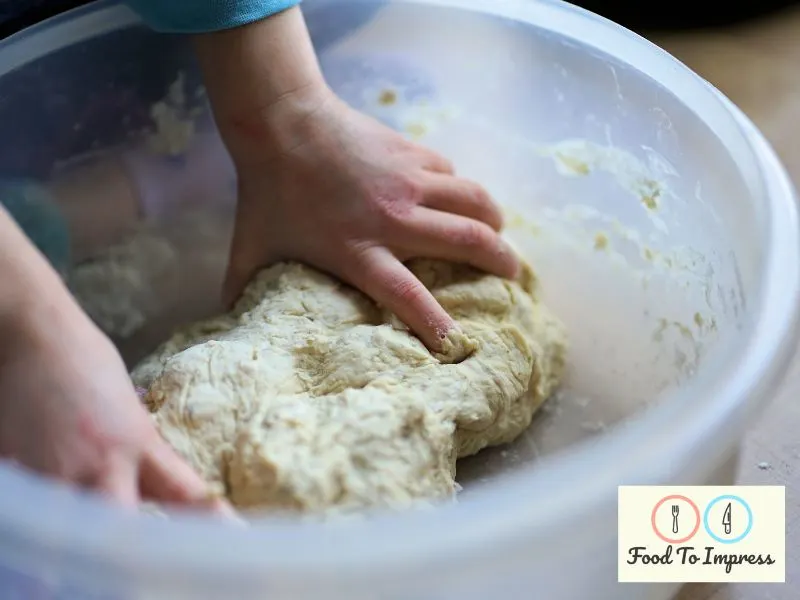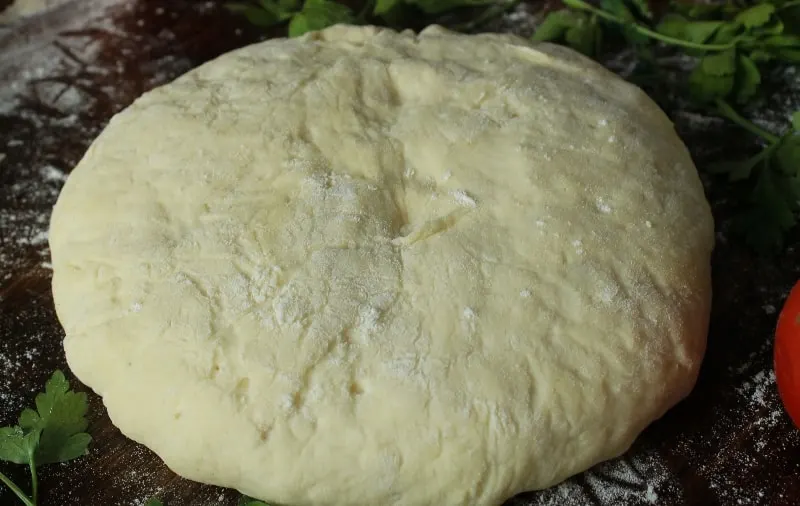Plenty of people have been in that terrible situation where their dough just hasn’t risen. It’s a huge letdown when you’re waiting for your dough to double in size and it doesn’t do anything. You sit there and wonder “if my dough didn’t rise can I still use it?” Fortunately, you don’t have to waste it by throwing it away since you can actually do other things with it.
If your dough hasn’t risen, then it’s not worth baking it as it is or it’ll be too dense to enjoy. Instead, you can roll it out very thin and bake it as a flatbread or a pizza. Alternatively, you can dissolve more active yeast in some warm water, then work it into the dough and see if it rises.
You might want to throw the dough out once you see that it hasn’t risen, but hold back on that and consider what else you might be able to do.
If it hasn’t risen, then you can’t make a full loaf of bread or thick pizza, but by turning the dough into a flatbread of sorts, you’re going to still get something that’s enjoyable to eat.
What To Do With Unrisen Dough
Although your dough might be completely flat, it’s not the end of the world since you can still use it. If you were to just bake it as it is, you’d be left with a very dense brick of bread, which isn’t very satisfying to eat, so you need to be creative with it and use it for things other than a loaf of bread.
If you haven’t already thrown it away, you can consider the options below in order to make sure that you’re not wasting it.
Add Active Yeast
When your dough didn’t increase in size, it’s most often because the yeast wasn’t good and couldn’t produce enough gas to rise it. What you want to do is get some new yeast and add it back into the dough.
To do this, you should get some warm water, add in some of the new yeast, and add a pinch of sugar or honey (optional). You just want to add enough water until the yeast is completely dissolved. Then I’d recommend leaving it for 5-10 minutes to check if it’s active (it should bubble and rise to the surface. If it doesn’t, it’s not active) before pouring it over the dough. Make sure this is in a bowl if you want to avoid a mess.
Now, you need to work the water and yeast mixture into the dough by squeezing everything together with your hands. It might take some work, but you should be able to fully incorporate the liquid in around 5 minutes. If it’s still wet after this time, you can knead in some more flour for a few minutes until it’s more handleable.
From here, you can cover the dough and leave it to rise until doubled in size. Then you can continue on with the recipe.

Make Flatbread
A great thing you can do is to use to dough for some kind of flatbread. It generally shouldn’t be used to replicate any kind of thicker flatbread, like naan or pita, but it can be used for bread like chapati or tortillas. Making it too thick will result in a tough flatbread.
To make flatbread, you should take portions of your dough, then form those portions into a ball and roll them out as thin as you can on a lightly floured surface. The thinner you can get them, the faster they’ll cook.
From here, you have two ways to cook them. You can either put them onto a baking tray/pizza stone in your oven, or you can cook them in a skillet. I personally prefer to cook them in a skillet since you can get better browning.
If you’re using your oven, you should set it to its highest setting in order for it to cook as quickly as possible. If you have a pizza stone, this will be ideal and you should preheat it with the oven, but if not, you can use a thick baking tray instead. Once the oven has heated for 30-60 minutes, you can put the thinly rolled dough onto the stone or baking tray, then bake until cooked. This can take anywhere from 2-6 mintues depending on the thickness of the dough.
If you’re using a skillet, simply preheat it over medium-high heat until lightly smoking. Then add a thin layer of oil, lay the dough into the pan and cook for 2-6 minutes, flipping once or twice during this time for even cooking.
Make Pizza
An alternative to flatbread is pizza, because who doesn’t love it?
This requires slightly more preparation and doesn’t produce amazing pizza, but it makes some pretty tasty thin-crust pizza. You wouldn’t want to do this with thick crust pizza since it’d be too tough.
You want to start by separating the dough into individual balls before rolling them out until they’re very thin. Then you can top it with sauce and cheese before putting it into your oven that’s been preheated to the maximum temperature for 30-60 minutes. This works best on a pizza stone, but will also work on a baking tray. Once in the oven, cook for 2-6 minutes or until the crust has firmed up and the cheese has melted.
You can also do this in a skillet by cooking the base in the skillet for a few minutes before putting it under the broiler to finish melting the cheese.
Give It More Time
Although it might seem like your dough hasn’t done anything, it might just be that you need to give it a little more time at the best temperature. Everyone’s kitchen environment is different, so your dough might not rise at the same rate as what the recipe says. If the recipe says to leave it to rise for an hour, yours might take 2 or more hours to double in size and be ready.
Getting the rising timing right is all about the experience. If you’ve never made bread before, then you won’t know when the dough is done rising. If you make it all the time, then you should know when it’s ready.
If you’re getting impatient with the dough, you can put it into a warm place to rise faster. You can put it into your oven with just the light on, this should provide enough heat to make the yeast more active and allow it to produce gas faster, which allows the dough to rise faster.

It’s Important To Figure Out What Went Wrong
Like any mistake, you need to learn what went wrong in order to avoid making the same mistake next time. Every mistake is a way for you to become better, so you shouldn’t brush off the mistakes you make like they’re nothing or you might make them again.
Here are the common reasons why your dough didn’t rise.
Dead Yeast
If your yeast is dead, it’s not going to be able to do anything and you can forget about it rising.
It’s wise to always test your yeast in some warm water before adding it to the remaining ingredients. You do this by mixing it into the water with a pinch of sugar or honey (optional), then wait for 5-10 minutes and watch for any activity. If the yeast rises and bubbles, it’s good to use. If nothing happens, you’ll need to go buy new yeast or try again.
Your yeast can be dead either because it’s old and has just died with time, or if you have added it to water that’s too hot, which has killed it. The water you use should only be around 100°F (37°C) in order to keep the yeast alive and active.
The Dough Was Too Dry
If there isn’t enough water in the dough, then the yeast won’t be able to move around freely and therefore won’t be able to rise the dough enough.
Dough is generally made too dry when too much flour is kneaded into it. If you’re kneading your dough in a mound of extra flour, then you’re probably drying it out at least a little.
Dry dough can also be caused by using volume measurements since it’s easy to use too much flour, so it’s best to always use weight measurements for the most consistent and reliable results.
So, always use weight and be sure to avoid adding too much extra flour when kneading.
Too Much Salt Or Sugar
Salt and sugar actually limit the speed at which the yeast can work, which slows how quickly the dough rises. If you were to make bread without salt or sugar, it would rise significantly faster (but it would also taste terrible).
You need to add just enough to control how quickly the dough rises in order to get the best results. By adding too much, you’re making the yeast, sugar, and salt all compete for the water in the dough, which puts the yeast at a disadvantage. Too much of either of these ingredients and they’ll suck the moisture right out of the yeast cells, causing them to die. And of course, your bread can’t rise if the yeast is dead.
Again, this problem can be caused by using volume measurements. You should be weighing your ingredients to avoid this mistake.
QUESTIONS OFTEN ASKED ABOUT DOUGH THAT DID NOT RISE
How do you fix dough that didn’t rise?
To fix dough that didn’t rise, ensure your yeast is fresh and not expired, and try letting the dough rise in a warm environment; if it still doesn’t rise, you might need to start over with new yeast.
Can you do anything with bread dough that didn’t rise?
Yes, you can still use bread dough that didn’t rise by baking it into a type of flatbread or using it to make crackers.
Can I still bake cinnamon rolls that didn’t rise?
You can still bake cinnamon rolls that didn’t rise, but they will be denser and less fluffy than usual; they might also not be as sweet, since the yeast hasn’t had a chance to develop the flavors fully.
Why is my dough not doubling in size?
Dough might not double in size due to factors such as expired yeast, insufficient proofing time, a too cold or hot environment, too much salt or sugar in the recipe, or improper kneading.
If pizza dough doesn’t rise, can you still use it?
Yes, you can still use pizza dough that didn’t rise. The resulting pizza will be more like a thin-crust pizza, as it will be denser and won’t have the light, airy texture typically associated with a well-risen dough.

